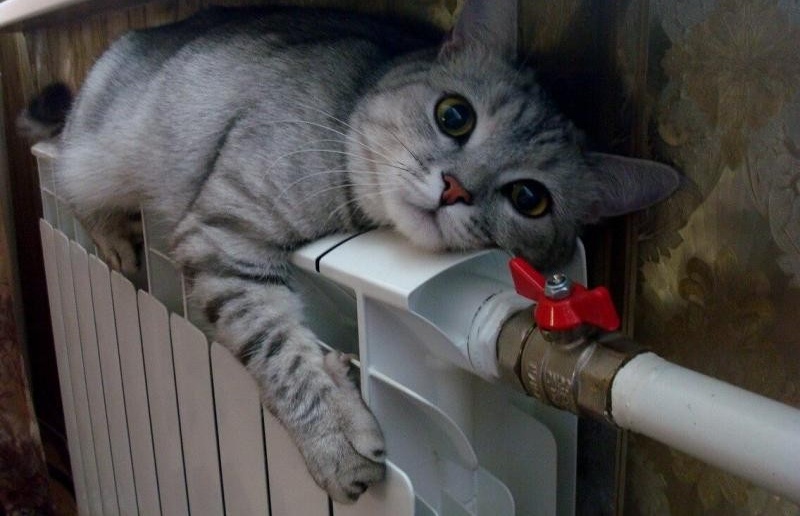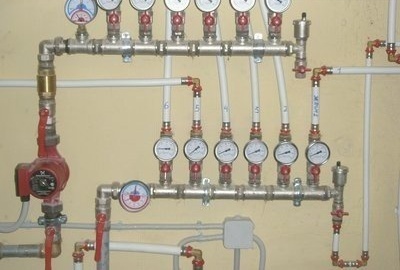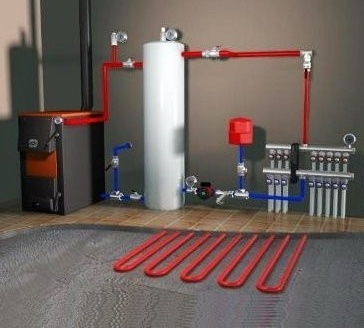The principles of the collector heating system: what is a collector and everything about its arrangement
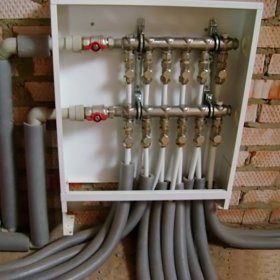
No matter how hard the engineers try, offering ever new methods of heating, but the traditional water heater is not going to give up its leading position. This effective and practical way to heat your home is quite satisfying for most developers. Rather, they are not interested in a radical change in the heating method, but in options for modernizing the traditional water system. These include a collector for heating, which replaces one and two-pipe structures. The device increases the efficiency, usability and maintainability of the system.
Collector: device and principle of operation
The node is an element in the form of a comb, from which the conclusions for connecting heating devices depart. The number of conclusions may vary. If necessary, the element can be increased by additional bends. Drainage and air exhaust valves, as well as heat meters, can be installed on the collector. Conclusions can be equipped with adjusting or shut-off valves, which makes it possible to regulate or disable the flow of coolant. The device is installed in the heating system in the form of a manifold block, which includes a return and feed comb, equipped with exhaust valves and corresponding taps.
The collector heating system functions quite simply. The heat carrier, heated by the boiler to the desired temperature, enters the feed comb. Here it is distributed between heating devices. A pipeline is laid to each of them, through which the coolant is directed. In the radiator, which has given up part of its heat, the liquid is partially cooled, and through the other pipe enters the return comb and from there to the boiler. This distribution contributes to uniform heating of the radiators, since a separate supply pipe is suitable for each of them.
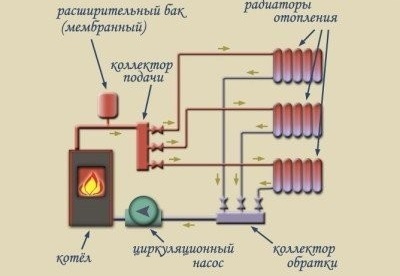
The coolant heated in the boiler goes to the supply manifold, where it is distributed through pipes suitable for each radiator. The cooled liquid through the return manifold is directed again to the boiler
Note! Distribution heating system combinstalled on each floor of a heated building, it is possible to obtain separate floor heating circuits with autonomous control. If the need arises, you can turn off the heating of the entire floor or just a few appliances, which greatly facilitates the maintenance and repair of the system. This will not affect the functioning of the entire structure. The use of the collector increases the efficiency of the equipment, since it is possible to install devices regulating the temperature and pressure of the coolant on its conclusions, as well as flow meters.
The nuances of organizing such a system
For a low-rise cottage or a private house, a collector heating system is considered the most reliable and efficient.Its arrangement will cost more than installing a two or one-pipe system. And this can be considered the only significant drawback of the device.
When planning a collector wiring, it should be borne in mind that it will not be able to function without a circulation pump. In addition, its installation is laborious and complex. It is better to entrust it to professionals if there is no experience in construction work. To install the system, a large number of pipes will be required, since individual wiring from the collector to each heating device must be performed.
Collectors can also be used when installing a floor heating system. Read more about this in our material:https://aquatech.tomathouse.com/en/otoplenie/teplyj-pol/smesitelniy-uzel-dlya-teplogo-pola.html.
What are the distribution combs?
Manufacturers offer many models of collectors. Among them, you can find devices with a maximum set of elements. The supply part is equipped with flow meters that regulate the flow of coolant in each loop, for a more uniform distribution. On the return, temperature sensors are mounted to monitor the temperature of each heater. The system allows you to automatically control the heating of each radiator. The cost of such a distribution comb for heating is quite high.
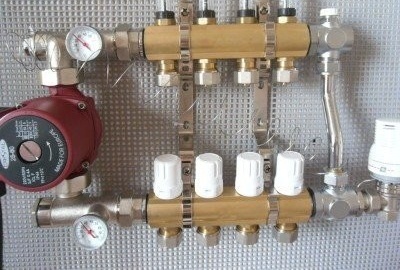
Collector block with a maximum set of functional elements. The supply part is equipped with flow meters that regulate the flow and pressure of the coolant. Thermal sensors installed on the return manifold
You can choose simpler options. For example, a brass element with an inch passage. The device has plugs on the return manifold, which allows you to install additional devices if necessary. There are cast parts and the simplest ones - with collet clamps for metal-plastic pipes. This is the cheapest and most problematic option. The device often “suffers” from possible leakage of coolant at the valve connection area, which is associated with rapid wear of the seal, which can not be changed always.
Craftsmen often independently make distribution combs. Perhaps the best of all options can be considered a stainless steel pipe of the desired diameter, to which the outputs are welded. But, despite all its simplicity, this is quite an expensive pleasure. And not only because of the cost of the pipe. You will need to install many more additional elements in order to get complete equipment. Therefore, many use the most budget option - a collector for heating, assembled from polypropylene tees, the right size of valves, etc.
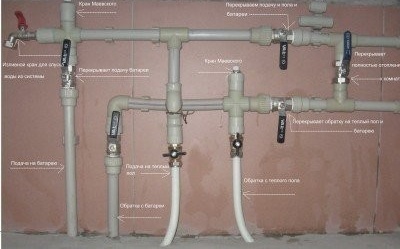
The most affordable and affordable collector. Self assembled from polypropylene tees, valves of the right size, pipes and other necessary parts
Where is better to install the equipment?
The ideal option would be to choose a place to install the collector during the design of the heating system. If the building has several floors, each has a place for the collector block. Most often, a niche in the wall is located under it, located at a small height from the floor. It should be in a room protected from excessive moisture. It can be a pantry, a corridor, etc.
The device can be mounted directly on the wall, if it is installed in the utility room, or placed in a special collector cabinet. The cabinet is a metal box with a door and a stamping, designed to bring pipes in the side walls. Inside the equipment, special mounts for the manifold block may be provided. You can find an invoice or a built-in cabinet option.
One of the varieties of collector heating systems is radiation. Read a detailed review of this system in our material: https://aquatech.tomathouse.com/en/otoplenie/razvodka-otopitelnoj-sistemy/luchevaya-sistema-otopleniya.html
Properly installed collector distribution of water heating guarantees the reliability and efficiency of the system. The probability of leaks due to the small number of compounds and tees is minimized. Hidden wiring is also possible, not violating the aesthetics of the room. And besides, agree that it is very convenient to adjust the heating temperature of each radiator and the entire room as a whole. A reliable system will be a real find for those who value their own comfort.
